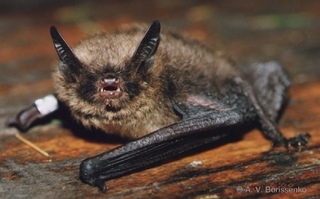
Brandt's bat
Order : Chiroptera
Family : Vespertilionidae
Subfamily : Vespertilioninae
Species : Myotis brandti
The Brandt's bat is listed as Least Concern (LR/lc), lowest risk. Does not qualify for a more at risk category. Widespread and abundant taxa are included in this category, on the IUCN Red List of Threatened Species
Namings for the Brandt
A young / baby of a Brandt is called a 'pup'. A Brandt group is called a 'colony or cloud'.Countries
Albania, Austria, Belgium, Bulgaria, Czech Republic, Denmark, France, Germany, Greece, Hungary, Italy, Kazakhstan, Latvia, Liechtenstein, Luxembourg, Mongolia, Netherlands, Poland, Romania, Russia, Slovakia, Spain, Sweden, Switzerland, Turkey and United Kingdom
Facts about the Brandt's bat
Brandt's bats are very closely related to whiskered bats, and were only recognised as being of a separate species in 1970.
Myotis brandtii - Brandt's Bat Brandt's bats are small with pointed faces well covered in dark hair.
Status and Distribution Whiskered and Brandt's bats are found throughout England and Wales.
Whiskered and Brandt's bats are so similar that even experts can find it hard to tell them apart and often refer to them simply as whiskered/Brandt's.
Whiskered and Brandt’s bats are probably more common in the north of the county than in southern Lancashire.
Brandt's Bat or Myotis brandti is listed on the IUCN Red list (1996) as Lower Risk/Least Concern . (Full text)
Myotis brandti is one (Full text)
Distinguishing features between whiskered and Brandt's bats are in the shape of the tragus, the teeth and the penis, which in Brandt's bat has a club-shaped tip. (Full text)
back to topThreats Brandt's bat is threatened by the decline of woodland, and intensive agricultural practices, particularly the use of pesticides. (Full text)
The Brandt's bat is not as widespread; it's range consists of all of Europe to the foothills of the Ural Mts. (Full text)
Brandt's bats are very similar in appearance to whiskered bats. (Full text)
More animals beginning with B
